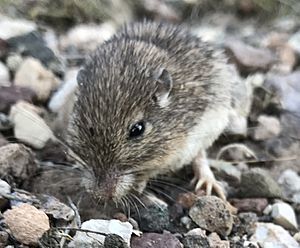Nelson's pocket mouse facts for kids
Quick facts for kids Nelson's pocket mouse |
|
|---|---|
 |
|
| Conservation status | |
| Scientific classification | |
| Genus: |
Chaetodipus
|
| Species: |
nelsoni
|
Nelson's pocket mouse, also known by its scientific name Chaetodipus nelsoni, is a small rodent. It belongs to a family of mice called Heteromyidae. You can find this mouse in parts of Mexico and the United States. Specifically, it lives in New Mexico and Texas. This special mouse was named after an American nature expert, Edward William Nelson.
Contents
Meet Nelson's Pocket Mouse
Nelson's pocket mouse is a medium-sized mouse. It has a long tail. Its total length, including the tail, is about 180 millimeters (7 inches). The tail itself is around 102 millimeters (4 inches) long.
What Does It Look Like?
This mouse has special fur-lined pouches on the outside of its cheeks. These are like tiny pockets! Its ears are small and shaped like ovals. The mouse has a slender body. Its front feet are small, but its back feet are larger. The fur on its rump, which is its lower back, has many stiff, grooved spines. These spines have dark tips.
The fur on its back and sides is brown. Each hair has a dark gray base, a grayish-fawn middle, and black tips. There is a lighter area around its eyes. Its belly is whitish, with a thin fawn-colored line separating the top and bottom colors. The tail has thin hairs on the front half. The back half has a crest of hairs, ending in a tufted tip.
Nelson's pocket mouse looks a lot like the lined pocket mouse (Chaetodipus lineatus). However, the lined pocket mouse does not have the stiff spines on its rump.
Where Does It Live?
Nelson's pocket mouse lives only in certain areas. It is found in western Texas, southeastern New Mexico, and central and northern Mexico. It lives in desert areas. These mice prefer places with sparse, scrubby plants.
Its Home Environment
You can find them on rocky slopes. These slopes often have plants like cactus, creosote bush, desert spoon, and Agave lechuguilla. They also live in sandy flat areas, among rock piles, in old walls, and around old buildings. Sometimes, they are found in bare, overgrazed pastures.
This pocket mouse is very common in most of the places it lives. It lives at altitudes up to about 2,025 meters (6,644 feet). This is just below where pine, oak, and juniper trees begin to grow. There are two types of Nelson's pocket mouse. One is C. n. canescens, found in the northern part of its range. The other is C. n. nelsoni, found in the southern part.
What Does It Do?
Nelson's pocket mouse is a nocturnal animal. This means it is active at night. It does not hibernate during the winter months.
Daily Life
During the day, it stays in its shallow burrow. A burrow is an underground tunnel. Its burrow usually has several openings. This is where it rests and raises its young. After the sun sets, it comes out to look for food. It tends to move from the base of one plant to another. It rarely stays in open areas for long. If it gets scared, it runs quickly instead of hopping.
Diet and Reproduction
This mouse mainly eats seeds. It collects seeds and stores them in its special cheek pouches. It also eats other parts of plants. Sometimes, it might even eat insects.
Nelson's pocket mouse breeds in the spring and summer. A mother mouse usually has about three young in a litter. The babies are born after about thirty days of pregnancy.
Is It Safe?
The number of Nelson's pocket mice changes throughout the year. There are many of them in late summer. However, their numbers decrease by the next spring. This is because only about 14% of these mice live to be one year old.
There are several national parks and protected areas where these mice live. No major threats have been found for them. Because of this, the IUCN (International Union for Conservation of Nature) says this pocket mouse is of "least concern". This means it is not currently in danger of disappearing.


